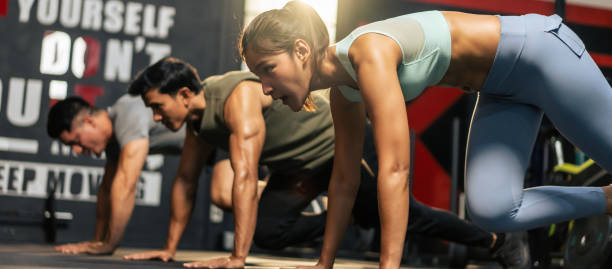Building a Strong Foundation: 4 Essential Elements for Effective Fitness Training
Are you tired of following countless fitness routines and diets with little to no results?
Want to unlock the secret to successful fitness training finally? Look no further!
In this blog post, we will unveil the four cornerstones for mastering the basics of your fitness journey.
Whether you’re a beginner or an experienced fitness and wellness enthusiast, these fundamental principles will become your guiding light toward achieving your health and wellness goals.
Get ready to revolutionize your approach and unleash your true potential as we delve into the key pillars of successful fitness training.
Without much ado, let’s dive in!

Indicators of Successful Fitness Training
As a fitness enthusiast, you have probably set goals for yourself and embarked on a fitness journey.
Whether you want to lose weight, build muscles, or just stay healthy, achieving your fitness goals requires dedication and hard work. But how do you know if your training is successful?
Here are sure signs that your dedication to fitness training is paying off:
Increased Strength and Endurance
Among the most obvious signs of successful fitness training is increased strength and endurance.
If you can lift more weight, run faster or longer, or perform more reps than when you started, then you are making progress.
Track your progress and celebrate even the smallest improvements. This will motivate you to keep pushing yourself to stay fitter.
Improved Body Composition
Improved body composition is another sign of successful fitness training.
A better body composition implies that you are losing fat and gaining muscle.
You may not see a significant change on the scale, but you will notice that your clothes fit better and you look more toned.
Advisably, don’t rely solely on the scale to measure your progress. Take measurements and progress pictures to see how far you’ve come.
Consistency
Consistency is key to successful fitness training.
If you have been consistently working out and following a healthy diet, then you are on the right track.
Consistency is what will help you achieve your goals in the long run.
Don’t give up if you don’t see results right away. Keep going and trust the process.
Better Sleep and Mood
Exercise is not only good for your physical health but also your mental health.
If you are sleeping better and feeling happier, then your fitness training is successful.
Exercise releases endorphins, which are natural mood boosters. It also helps reduce stress and anxiety, which can interfere with your sleep.
If you are feeling more energized and less stressed, then keep up the good work.
Improved Performance in Daily Activities
Fitness training should not only improve your performance in the gym but also your daily activities.
If you can carry groceries without getting tired, climb stairs without feeling winded, or play with your kids without getting exhausted, then your fitness training is successful.
These small improvements in daily activities may not seem significant, but they are a testament to your improved fitness level.

Unlocking Your Potential: The 4 Principles of Successful Fitness Training
In your quest for mental and physical wellness, you are likely always on the lookout for ways to improve your workouts. But with so much information out there, it can be difficult to know where to start.
Below are the four cornerstones of successful fitness training:
1. Cardiovascular Endurance
Cardiovascular endurance refers to the ability of your heart, lungs, and blood vessels to effectively transport oxygen to your muscles during exercise. Essentially, it’s a measure of how efficiently your body can use oxygen to produce energy.
Training for cardiovascular endurance can improve your overall health and reduce your risk of chronic diseases such as heart disease, diabetes, and obesity. It can also increase your stamina and energy levels, allowing you to perform daily tasks with greater ease. Additionally, training for cardiovascular endurance can improve your mental health by reducing stress and anxiety levels.
So, how do you go about training for cardiovascular endurance?
You can do various exercises to improve your cardiovascular fitness, including running, cycling, swimming, and rowing. These exercises require sustained effort over an extended duration, forcing your body to adapt and improve its ability to use oxygen efficiently.
Please note that cardiovascular endurance shouldn’t be the only focus of your fitness routine. Incorporating strength training and flexibility exercises are also important for overall health and injury prevention.
To improve your cardiovascular endurance, it’s recommended to perform moderate-intensity cardiovascular exercise for at least 30 minutes per day, five days per week. As you become fitter, you can gradually increase the intensity and duration of your workouts.
In addition to traditional cardio exercises, various high-intensity interval training (HIIT) workouts can help you improve cardiovascular endurance. These workouts involve alternating bursts of high-intensity exercise with short periods of rest. For this reason, HIIT exercises are a great way to challenge your body and improve your fitness level.
2. Muscular Strength
Muscular strength refers to the ability of your muscles to generate force against resistance. Simply put, it is the amount of weight you can lift or the force you can exert. When you train for muscular strength, you work to increase the size and strength of your muscles, which can have numerous benefits for your overall health and fitness.
Training for muscular strength improves your physical performance in various activities.
Whether you’re a runner, a weightlifter, or just someone who enjoys playing sports, having greater muscular strength can help you perform better and reduce your risk of injury.
Strength training also has significant benefits for your bone health. As you age, your bones naturally become more fragile, which can increase your risk of fractures and other injuries. By engaging in regular strength training, you can help maintain and even increase your bone density, reducing your risk of osteoporosis and other bone-related conditions.
In addition, training for muscular strength offers aesthetic values.
By building larger, stronger muscles, you can achieve a more toned and sculpted physique that will help you feel more confident and comfortable in your own skin.
So, what exercises should you perform to attain muscular strength?
The most popular and effective exercises for building muscular strength include the following:
- Squats – This exercise targets the muscles in your legs, glutes, and lower back, making it a great option for building overall lower body strength.
- Deadlifts – Deadlifts are a compound exercise that works a variety of muscle groups, including your legs, back, and core. They can be performed with a barbell or dumbbells and are an excellent option for building full-body strength.
- Bench Press – The bench press is a classic exercise for building upper body strength, targeting your chest, shoulders, and triceps.
- Pull-Ups – Pull-ups are an excellent exercise for building upper body strength and targeting your back, shoulders, and biceps. If you’re new to pull-ups, you can start with assisted pull-ups or use a resistance band to help support your weight.
- Lunges – Lunges are another great lower body exercise that can help build muscular strength in your legs and glutes. They can be performed with body weight or weights and can be modified to suit your fitness level.
Incorporating these exercises into your fitness routine can help you build greater muscular strength, improve your physical performance, and achieve your aesthetic goals.
Just remember to start slowly and gradually increase your weight and intensity over time to avoid injury and ensure continued progress.

3. Muscular Endurance
Muscular endurance refers to the ability of your muscles to exert force repeatedly over an extended period.
Training for muscular endurance can improve your overall fitness level and athletic performance.
Improved muscular endurance allows you to perform more repetitions or sets of an exercise without experiencing fatigue or muscular failure. This translates to being able to lift heavier weights, run longer distances, or perform more challenging bodyweight exercises.
Training for muscular endurance also has positive effects on overall health. It increases your metabolism, which can lead to weight loss or weight management. It also improves your cardiovascular health by increasing your heart rate and strengthening your heart and lungs.
So, how can you train for muscular endurance?
Among the most effective ways to train for muscular endurance is to perform high-repetition sets of an exercise with a relatively light weight. For instance, you might perform three sets of 20 repetitions of bicep curls with a 5-pound weight.
Another effective way to train for muscular endurance is to perform bodyweight exercises with high repetitions.
Bodyweight exercises include push-ups, squats, lunges, and planks. To increase the challenge, you can add variations to these exercises, such as plyometric push-ups or jump squats.
Incorporating circuit training into your routine is another great way to train for muscular endurance.
Circuit training involves performing a series of exercises back-to-back with little to no rest in between. This can include a mix of weightlifting and bodyweight exercises. The goal is to complete the circuit as quickly as possible while maintaining proper form and technique.
For the best results, don’t forget to incorporate cardiovascular exercise into your routine. Activities like running, cycling, or swimming can help improve your muscular endurance by increasing your heart rate and strengthening your heart and lungs.

4. Flexibility
Flexibility is the ability of your body to move freely and effortlessly without any hindrances or limitations. It is an essential aspect of fitness that you should prioritize.
Flexibility training, also known as stretching, is an integral part of any workout routine and offers numerous benefits to your overall health and fitness.
Flexibility training prevents injuries.
When your body is flexible, it is less prone to strains, sprains, and other injuries that can occur during physical activity. Stretching helps to warm up your muscles, increase blood flow, and improve your range of motion, which can protect your body from injuries.
Flexibility training also improves your posture.
Many people spend a lot of time sitting in front of a computer or hunching over their phones, which can cause poor posture and contribute to back pain. Stretching can help to alleviate these issues by improving your spinal alignment, reducing tension in your muscles, and improving your overall posture.
Flexibility training can also enhance your athletic performance.
When your muscles are flexible, you can move more efficiently and with greater ease, which can improve your performance in sports and physical activities. Stretching also improves your balance, coordination, and agility, helping you excel in your chosen sport or activity.
Some popular stretching exercises to help you attain flexibility include:
- Static stretching: This involves holding a stretch in a comfortable position for a set amount of time, usually around 15-30 seconds.
- Dynamic stretching: This involves moving your body through a range of motions to warm up your muscles and improve your flexibility.
- Proprioceptive neuromuscular facilitation (PNF) stretching: This involves contracting and relaxing your muscles while stretching to improve your range of motion.
- Yoga: Yoga is a form of exercise that combines stretching, strength, and balance. It is an excellent way to improve flexibility and overall health.
When performing flexibility exercises, start slowly and gradually increase the intensity and duration of your stretches. Be sure to warm up your muscles before stretching and listen to your body to avoid overstretching or injury.

Over to You…
Successful fitness training is not just about achieving a certain weight or body shape.
It’s about improving your overall health and well-being. Keep track of your progress, celebrate your achievements, and don’t give up if you hit a plateau.
With consistency and dedication, you will achieve your fitness goals and enjoy a healthier and happier life.
Looking to build muscle and endurance without breaking the bank? Don’t look any further.
Subscribe to Kloud Iron’s 28-day fitness program and begin your journey toward optimal mental health and physical fitness.
To learn more about Kloud Iron Fitness Hub’s offers, contact us today or message/follow us on Facebook and Instagram. We are also available on YouTube.


1 Comment
registrarse en www.binance.com
4 months agoCan you be more specific about the content of your article? After reading it, I still have some doubts. Hope you can help me.